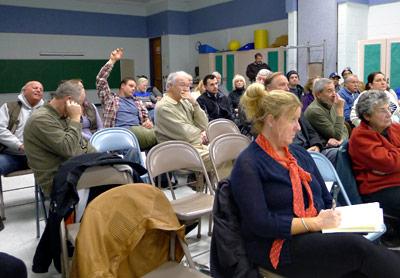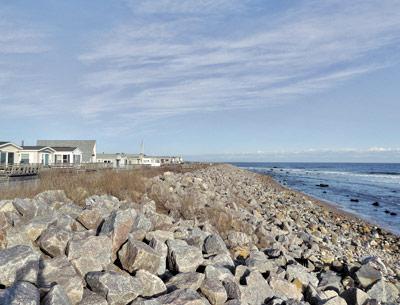Buckhorn Tops Ol’ Blue Eyes
Buckhorn Tops Ol’ Blue Eyes

To the surprise of many in the audience, Tom Sperry, an employee of the Meeting House restaurant in Amagansett Square who had just delivered a vocal performance uncannily reminiscent of Frank Sinatra, was not crowned Mr. Amagansett at last Thursday’s fifth annual pageant.
Instead, the honor was bestowed on one Billy Buckhorn, a k a East Hampton Town Councilman Peter Van Scoyoc. Mr. Van Scoyoc, in the guise of a deer, played an electric guitar and sang plaintively about the plight of his species in a town where bullets, vehicles, and proposed sterilization schemes are a constant threat.
The pageant, a fund-raiser for the Donald T. Sharkey Memorial Community Fund, drew a large crowd to the Stephen Talkhouse, where eight contestants vied for the title. Mr. Sharkey, formerly the town’s chief building inspector, died in 2009.
Donations were still being tallied on Monday, but Britton Bistrian, one of five judges of the pageant, said that the fund would likely cover either the annual $2,500 scholarship to a community-minded student or the annual $1,500 donation to the Wounded Warrior Project.
Peter Honerkamp, an owner of the Talkhouse and perennial losing contestant in the pageant, introduced the event by welcoming the “seven or eight idiots who once again participate.”
Prior to the competition, a video depicting the late Carl (the Greek) Gust, a bartender who worked at the Talkhouse, was shown. Mr. Gust, a contestant in the first Mr. Amagansett pageant in 2010, was the deserving winner of that competition: The video had last Thursday’s audience in hysterics, along with many of the Talkhouse staff who were impersonated by Mr. Gust in his performance. Mr. Gust, who died in 2012, was also the grand marshal of the Am O’Gansett parade that year.
Performing as Boo Bonac, Gordon Ryan, an attorney, once again sought the title with his sidekick, the Plague. Once again Mr. Ryan demonstrated either an unwillingness or inability to carry a tune.
Two UpIsland men, from Sayville and Selden, followed, each delivering a bawdy stand-up routine. “You get an ‘A’ for effort. That’s about it,” Mr. Honerkamp told the first upon his performance’s conclusion. “Nail it,” he begged the second as he took the stage. “Save us.”
Nick Kraus, a manager of the Talkhouse, was in San Diego for a Soldier Ride event and unable to attend. In his place, a short film provided laughs that had theretofore been in short supply. Mr. Honerkamp’s entry, also via video presentation, also drew laughs. The self-described “least interesting man in the world” poked fun at himself and his myriad frustrations.
Marco Marin, a bartender at Indian Wells Tavern, thrilled but ultimately disappointed some in the audience with an aborted striptease. Mr. Honerkamp’s exhortations to return to the stage and complete his performance went unanswered; the crown would not be his.
Finally, Mr. Sperry dazzled the crowd with his song and snappy attire, singing his own, localized lyrics to Jimmy Van Heusen and Sammy Cahn’s “My Kind of Town,” popularized by Sinatra. Mr. Sperry’s channeling of Ol’ Blue Eyes was remarkable, and the Talkhouse crowd erupted in cheers long before he had finished.
Ms. Bistrian congratulated Mr. Sperry for “an amazing freshman effort,” but announced that the coveted title belonged to Mr. Van Scoyoc. Mr. Sperry, Ms. Bistrian wrote in an email, was “a showstopper with talent.” But, she wrote, what swayed her and her co-judges, Erica Yardley, Maura Gledhill, Beth Baldwin, and Debbie DiSunno, was “the humor in Peter’s performance about the timely issue of the deer cull.” Mr. Van Scoyoc “took an intriguing position of a buck that would rather be shot than have his does sterilized,” she wrote.
During his performance, Mr. Van Scoyoc occasionally paused to remove an oversized, felt “tick” from his furry costume, which he then threw at the judges. The town councilman’s humorous take on current events put him over the top, in the judges’ eyes.
“It was a tough debate,” Ms. Bistrian wrote, “but in the end it came down to the uniqueness and humor, and the desire to see Tom perform again next year.”






